
by Judy Biss | Mar 27, 2015

Freshwater Jellyfish, Craspedacusta sowerbyi, Lankester, 1880. Photo Credit: U.S. Geological Survey Archive, U.S. Geological Survey, Bugwood.org
Yes, you read the title correctly, it says freshwater jellyfish in Florida! The first time I encountered these unusual aquatic creatures was while swimming in a small lake in southern Indiana. It turns out these jellyfish, while not very common, have been found in almost every state in the U.S. This jellyfish is known as a hydrozoan, a tiny aquatic invertebrate animal. It grows into a few different forms during its life-cycle and is most easily identified when it takes the form of the small jellyfish. This form during its life-cycle is known as a hydromedusa and measures up to about 25 mm in diameter, which is a little larger than a penny.
The scientific name for this unusual organism is Craspedacusta sowerbyi and it is native to the Yangtze River valley in China. It was first described to science in 1880 from specimens collected in water lily tanks in London. This freshwater jelly is now common in temperate climates almost worldwide, and was most likely introduced into the US attached to ornamental aquatic plants and fish.
Hydromedusae, the form that looks like a jellyfish, are produced only sporadically from their otherwise immobile attached form known as a polyp on lake and river bottoms. Sightings of the jellyfish are most common in summer and fall but may go several years between occurrences. The freshwater jellyfish mainly eats tiny aquatic zooplankton, catching them with their stinging tentacles. They are not considered dangerous to humans.
The impact this non-native freshwater jellyfish may have on aquatic ecosystems is not well known. Sightings of this organism are being recorded by the U.S. Geological Survey Nonindigenous Aquatic Species Information Resource and EDDMapS (a web-based mapping system for documenting invasive species distribution, launched by the Center for Invasive Species and Ecosystem Health.)
Based on data from these resources, the freshwater jellyfish, Craspedacusta sowerbyi, has been found in the following north Florida counties: Escambia, Walton, and Washington counties, and in the following peninsula Florida counties: Lake, Hernando, Highlands, Orange, Miami-Dade, Pasco, and Putnam.
So, while you’re enjoying your favorite freshwater swimming hole this summer, keep a sharp eye out for these harmless, fascinating, yet non-native, jellyfish! If you find them, report your sightings here at EDDMaps.
Information from the following resources were used to write this article:
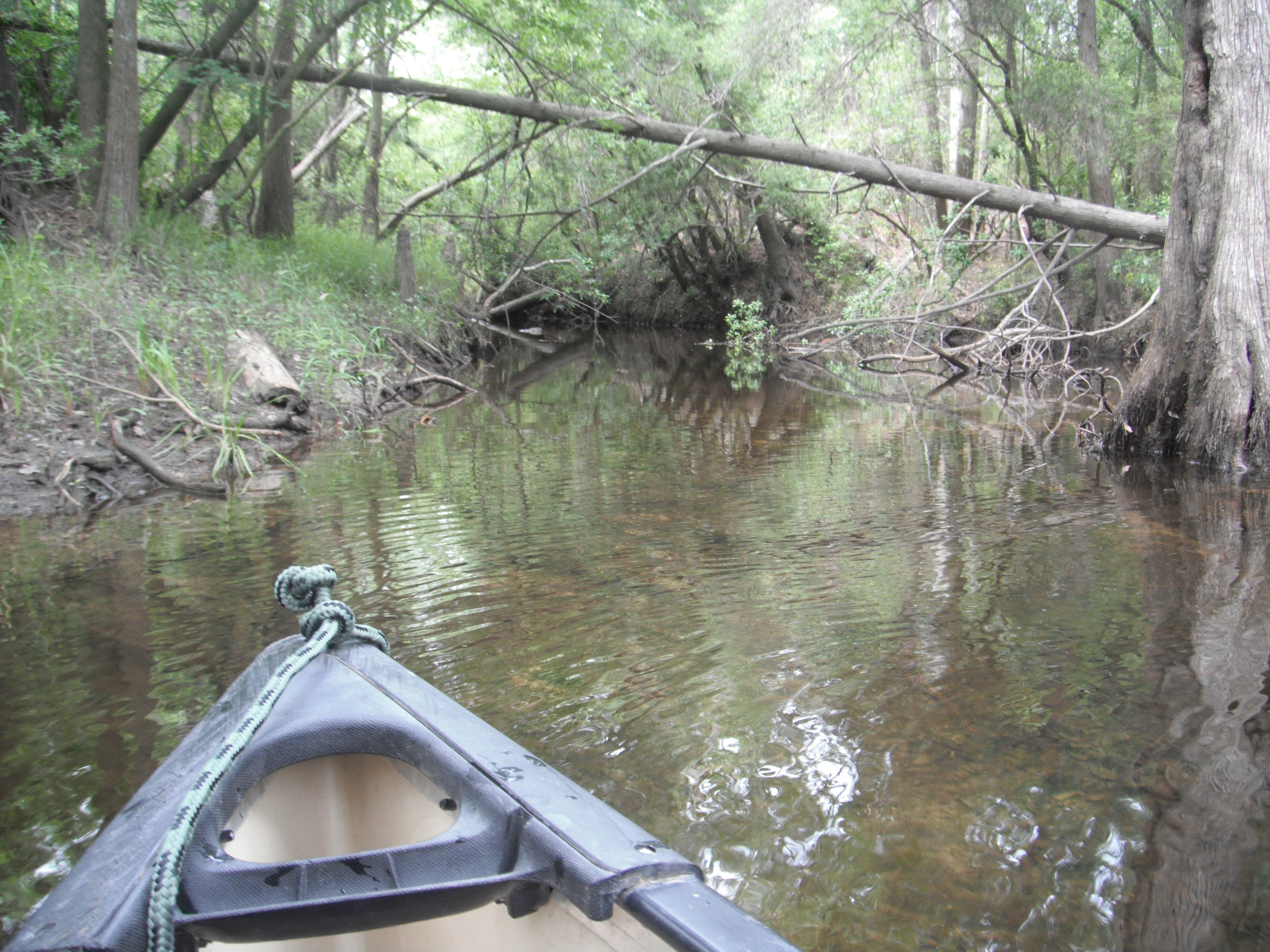
by Carrie Stevenson | Mar 27, 2015
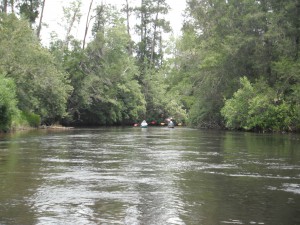
Canoeing in Perdido River Photo credit: Carrie Stevenson
This time of year, many families are looking for ways to entertain their kids during spring break. For those not planning to travel far, our area is full of fun, and often inexpensive, outdoor adventures.
As part of a series of field excursions led by Extension Agents over the past few years, we’ve been able to introduce visitors and lifelong residents of the panhandle to some tremendous natural resources that are right at our back door.
Following are three examples of family friendly trips worth marking off your “Florida bucket list.”
Perdido River: the natural border between Alabama and Florida, the Perdido stretches over 65 miles from its source near Atmore, Alabama and ends up at Perdido Key in the Gulf. Clean, clear, and sandy-bottomed, the Perdido River is a perfect spot to tube, kayak, canoe or paddleboard and several local outfitters can provide equipment. While on the river, you might experience a flyover from a bald eagle, see towering bald cypress, or explore shallow backwater springs and swamps.
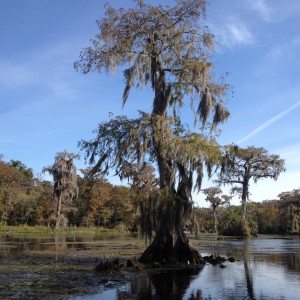
Majestic bald cypress trees serve as wildlife habitat at Wakulla Springs State Park. Photo credit: Carrie Stevenson
Further east is Florida Caverns State Park in Marianna. This region is one of the most biodiverse in the state, with endemic tree species—like the Florida Torreya, found only in three counties in the state—along with many hardwood species found more typically in the central Appalachians. The extensive limestone cavern and spring systems in Jackson County are home to beautiful swimming/diving spots as well as the caverns. The ranger-led tours are excellent, as well as the hiking trails within the park grounds. The cave tour takes about an hour and is mildly strenuous. There are no tours on Tuesday or Wednesday, so keep this in mind when planning a visit.
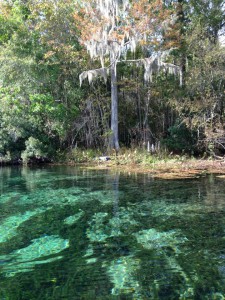
The crystal clear springs of Wakulla are home to alligators and manatees. Photo credit: Carrie Stevenson
At the edge of our district is Hollywood-famous Wakulla Springs. Film site for both “Tarzan” and “Creature from the Black Lagoon”, the spring teems with wildlife year-round. A guided tour via pontoon boat will bring you up close to manatees, alligators, ospreys, anhingas, and large herons. Hiking trails, a swimming hole, and the historic lodge and restaurant are open to visitors as well. The nearby Chipola River is also a beautiful spot to paddle.
Every county in the Florida panhandle has tremendous water resources, from the Gulf to inland rivers and even waterfalls. Take time to explore on your days off this spring!

by Rick O'Connor | Mar 21, 2015
What many have been waiting for… spring is here! HAPPY EQUINOX EVERYONE!
Today’s photoperiod will be 12 hours of daylight and 12 hours of darkness – equinox. Many cultures around the world celebrate this and many ancient cultures built great structures to celebrate the event. It is also a time that many forms of plants and wildlife on our barrier islands begin to awaken and become more active.

The spring equinox sunrise over Santa Rosa Island, March 21
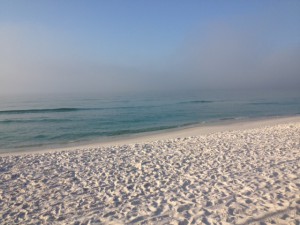
Fog rolling over the Gulf of Mexico in the early morning.
You might remember in our January edition of this series we showed the low angle of the sun over the Gulf on a January morning. Here we see the sunrise is slightly higher. The equinox is a special time of year for many. Moving form the cooler winter temperatures to the milder spring we typically will find water vapor condensing near the earth’s surface forming fog. This first morning of spring was no different. As the day warmed quickly the fog “burned off” producing a fabulous sunny warm day for all.
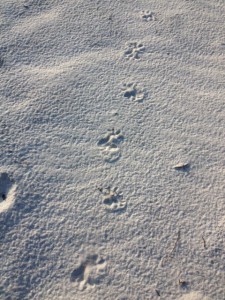
The spread toes of the opossum make identifying this track easier.
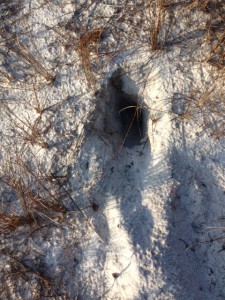
Armadillo digs are evidence of night time insect raid by this animal.
We did not see any live mammals moving across the dune fields but we did see plenty of tracks of the presence. We could identify at least 4 different types of creatures moving across the dune faces with all sorts of crossing patterns indicating these longer warner days have them moving. After lying dormant during the colder months it is time to find food, and for some, mates. Many of the mammals on the barrier islands are nocturnal in habit but may be spotted in the early mornings or late afternoons.
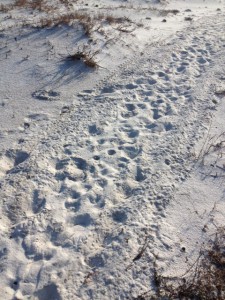
Tracks of an ATV moving across a dune face near the sound side of the island.
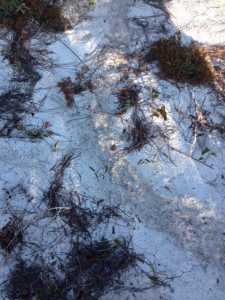
The mysterious unknown drag.
We were not sure whether this ATV track was from an official vehicle checking on something or from a local who did not want to walk all the way to the sound, but we would remind everyone that vehicles such as these are not allowed on the dunes and can cause much damage. I have been hiking this area for years and this is the first vehicle track I have seen in a long time. If you are interested in fishing the sound and can not access by boat, there are other locations on the island where the walk is much closer. Please consider walking there.
We once again we found the “mysterious drag” mark. Each month since I began this series we have found these drag marks near one of the salt marshes. Each time it appears that something has either crawled or has been dragged from the water to the top of a small sand ridge and then… abruptly stops. Not sure… have not been able to find claw marks, tail drags, etc. Just what you see in the photo above. We are going to find out though!
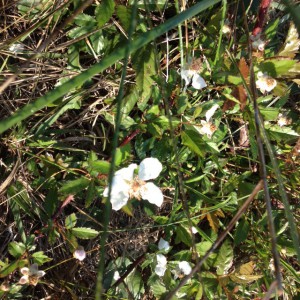
The bloom of a black berry.
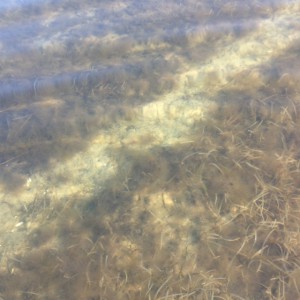
The scarring of seagrass but a propeller.
For early spring we did not see many blooming plants. Last month the beach heather (Conradina) began to bloom, and much of it was in full bloom this month, but the only other bloom we found was that of the dewberry, called blackberry by many locals. This plant will eventually produce sweet berries which is enjoyed by many animals on the barrier islands… including hikers.
Prop scars are a common site during the summer months and the fact that we saw several today indicate that many are “itching” to get their boats out and enjoy our bay. Prop scars are problem though. Seagrasses are an important ecosystem in our local estuaries. They provide food and shelter for a great variety of marine creatures including commercial important ones. In general seagrasses have declined in our state over the last few decades. Causes include increased turbidity, decrease in salinity, increase in sedimentation (all caused by increase runoff), and damage such as prop scarring. Many of lawn grasses can grow after being mowed too low but they are, at times stressed and take time to recover. This is the case with some species of seagrass. Turtle grass, one of the more common found in our sound, can take several years to recover from severe scarring. We know that boaters want to “bring her up on the beach” for a day in the sand and sun, but avoiding seagrass beds when doing so benefits the local marine life.
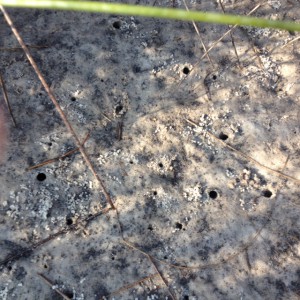
The burrows of fiddler crabs.
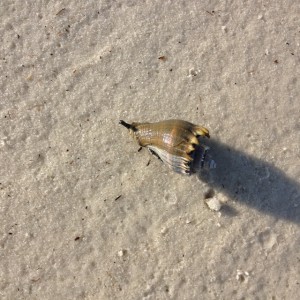
The crown conch.
On this early spring morning we did not find a lot of wildlife moving in and near the salt marshes. Gone were the cannonball jellies we had seen in the winter and there were no dead fish from cold stress on the beach. We did find the burrows of the common fiddler crab. These small crustacean digs burrows down to the water table where they end in a chamber. These chambers are half filled with water and keep their gill chambers moist. During high tide the fiddler crab will block the entrance of the burrow with sand and wait it out down in the chamber. When low tide arrives they emerge to feed on organic material within the sand, forming round pellets that resemble coco-puffs, and socialize. Fiddler crabs are very social and form large groups which remind one of the great herds of buffalo on the plains of the 19th century. The males have one claw (cheliped) larger than another. They use this to “wave” at the females and rub their legs to generate sounds to attract her. They use their small cheliped for feeding. They are popular prey item for creatures like shorebirds, fish (if they venture into the water), raccoons, and terrapins.
The Crown Conch is a common predator of our bays and bayous. This snail prefers higher salinities of 20 – 30 parts per thousand, which keeps them in the lower parts of our estuary, but there they are quite common. This time of year they begin moving along the shallow waters of grassbeds and salt marshes searching for other mollusk to feed on, they will also scavenge dead organisms. There are separate males and females in this snail who produce a linear string of egg capsules which they attach to seagrass, roots, rocks, or some other structure. They have their own predators, such as horse conch, who lurk in the deeper waters of the sound. Their scientific name, Melongena corona, describes their “crown” they appear to have. These can reach lengths of 8″ but most are much smaller. The larger ones are known to be cannibals.
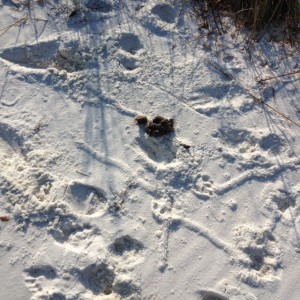
Evidence of dogs on the beach.
The last thing we found on this first day of spring was evidence of dogs running the beach. Many people are dog lovers, including me, and there are areas on the island where dogs can enjoy the sand and surf. However they are not allowed on all beaches. There are several problems with dogs on the beach. One their feces, like all feces, harbors bacteria and piles such as this can easily be washed into the water. Increase in fecal coliform bacteria in the water column can be a health concern. Dogs outside of the areas where they are allowed can kill island wildlife. This time of year many species of shorebirds begin nesting on the sands of these beaches. Dogs in the area can cause the parents to fly off the nest leaving the eggs (or hatchlings) exposed to predators and extreme temperature changes. Many of our island shorebirds are protected species and need our help to assure as many young as possible survive. Finally, there will be other families following you… who wish to set up chairs and towels and have their kids play in the water and sand… they really do not want to encounter this. So please let you pet enjoy the beach but in areas where they allow it.
We will see what April brings to the beach.
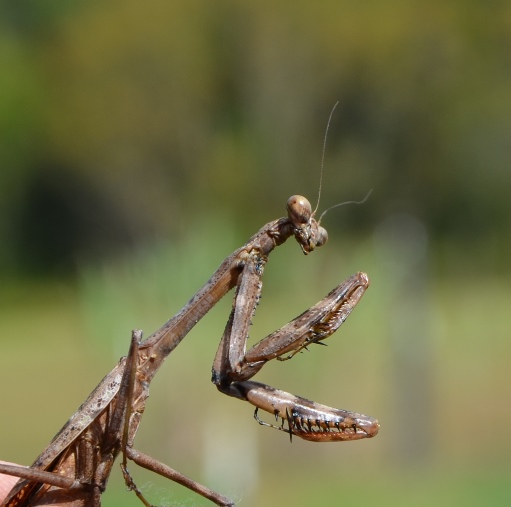
by Les Harrison | Mar 20, 2015

The preying mantis is well equipped to thin the population of destructive insects.
The last two years have been kind to the insect population in north Florida, and 2015 appears to be continuing the trend. The weather has provided enough rain for those bugs which depend on the generous supply of foliage and the temperatures are returning to an agreeable range for population growth.
Stink bugs, leaf-footed bugs, grasshoppers, all sizes of caterpillars and many more are hatching bent on enjoying the lush and plentiful dining selections. Homeowners and gardeners may soon be plagued by the sudden appearance of hordes of hungry pest which are eyeing the menu choices at a residence’s landscape.
Fortunately, nature has a way of equalizing all situations when left to its own devices. With the increase of the plant eaters comes those insects which restrain their population explosions.
One of the most easily recognized predator insects is the praying mantis. This beneficial insect is actually a family with multiple members, some of which have been introduced to Florida.
While there are over 2400 mantis members worldwide, Florida is home to eleven natives. Two of those have been introduced from other regions, but are not considered invasive.
Mantises are thought to have evolved during the Cretaceous period about 100 million years ago, possibly from a predatory cockroach with similar front legs. Their closest surviving insect relatives are cockroaches and termites, both of which they will consume if given the opportunity.
Like many insects, the mantis is equipped with a tough, durable exoskeleton which provides a basis for successful close quarter combat and meal procurement. These hunters have three other advantages which create a severe vulnerability in their prey’s defense and potential for surviving a mantis encounter.
The mantis is an ambush predator which will lay in wait for the victim/meal to deliver itself. The mantis has the instinctive ability to identify and hide in areas with high amounts of prey traffic.
This insect is a master at stealth and camouflage. The creature’s coloration and linear shape allow it to blend into the many natural settings.
To complement this facility to conceal itself in plain sight, the mantis can hold perfectly still and patiently wait for the oblivious animal to bumble into sticking range. At that precise moment, the mantis is a blur of lethal motion.
The mantis’ forelimbs are a set of deadly spiked vices used to immobilize and secure its target. It extends these spiny levers forward in a raised position which appears as though it is in prayer, hence its name.
The intended kill technique is to impale and restrain the victim with a single stroke of the forelimbs while holding the victim securely to the mantis’ body. On occasion the attempt fails and the mantis has to apply a more direct approach.
This insect’s beak is designed for slicing and tearing its victims flesh. The jaws provide the power to effectively employ this means to its meal’s head.
Depending on its stage of life, the mantis will eat a wide variety of creatures. Early stage mantises will eat little flies and other tiny insect (including its siblings), but at maturity they will take on small reptiles and amphibians along with a variety of destructive insects.
Despite its vicious nature, the praying mantis is the soon-to-emerge answer to many gardeners’ prayers.
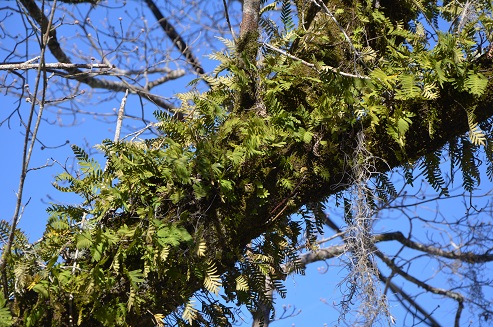
by Les Harrison | Mar 13, 2015

Resurrection ferns are found in many mature hardwood trees in north Florida. This fern is an air plant which prospers on skimpy amounts of water and plant nutrients.
One of the wonderful features of spring is the return of green to the branches of many trees in north Florida. Cypress, poplar, cherry and many others have been defoliated by the cool season which is now retreating.
Buds are breaking everywhere deciduous trees reside and changing the complexion of the landscape. Every day the browns and grays are giving way to intensifying shades of green.
Aside from the pines, magnolias and live oaks, there has been green in the branches of some hardwood trees which went through the winter. Resurrection ferns have remained green in their sheltered perches as the seasons change.
Pleopeltis polypodioides, the scientific name for this native fern, has easily flourished through the recent winter with sufficient moisture. This creeping, coarse textured fern is commonly found in the southeastern United State, but also in some African locations.
It has been commonly identified as a resurrection fern because it has the capacity to survive long periods of drought. During dry times the leaves brown and wither, but the roots and leaves survive by stingily conserving water.
When rains return this fern quickly regenerates by promptly circulating water to the leaves through the plants highly efficient vascular system. To the casual observer, it appears to return from the dead in about a day.
The resurrection fern is an air plant, or epiphyte, which attaches itself to other plants. It receives the necessary plant nutrients for growth from several sources.
Bacterial activity on the outer surface of its plant host’s bark is a major contributor. The outer bark layer of many plants and trees is in the process of being shed and is an ideal location for this fern to grow.
Other tiny particles of nutrients are delivered through rain water and on the breezes. Though meager in life sustaining supplies, the resurrection fern flourishes in this harsh environment where most plants would quickly die.
Though usually located on tree branches, resurrection ferns are sometime seen growing on rocks, bricks or deadfall logs. It is not rare to see this fern growing with another native epiphytic plant, Spanish moss.
This plant’s root system are tiny and shallow, as could be expected of a fern which grows on the outer layer of bark. It uses an intricate mesh of rhizomes which meander just beneath the bark’s surface.
These rhizomes are part of the ferns ability spread along the branches and colonizes new sites on the tree or plant. Periodically the roots will emerge on the bark’s surface and sprout leaves.
The other method of propagation and species preservation is through spores which are produced on the underside of the leaves. Most leaf tips have a mechanism to generate a high volume of tiny wind delivered spores.
During summer and early autumn, the spores ripen and are scattered on the prevailing breezes. While only a tiny fraction make it to a hospitable site, the ones which do quickly establish themselves.
So if 2015 produces a dry or wet summer, resurrection ferns will be here. If only other plants were as easy to tend.




















